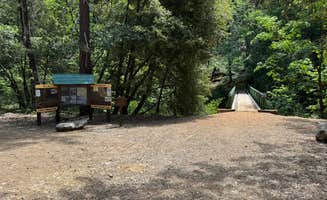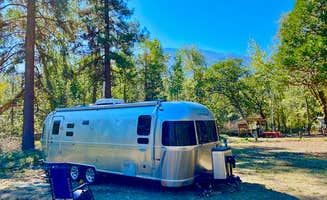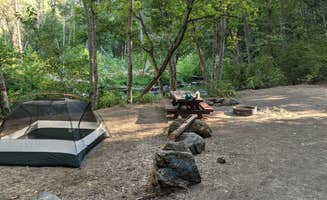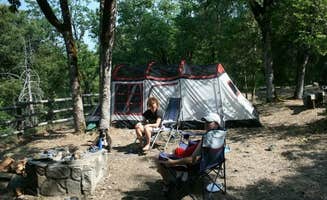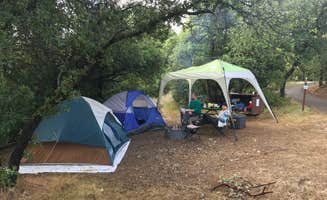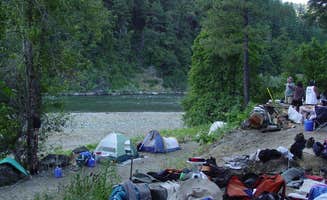Dispersed camping near Greenview, California provides access to the Trinity and Scott Rivers plus surrounding national forest land. The region sits at approximately 2,600 feet elevation with hot, dry summers and cold winters that often bring snow at higher elevations. Most dispersed camping sites require vehicles with moderate clearance, though accessibility varies significantly by season and recent weather conditions.
What to do
River activities: Tree of Heaven Campground offers direct Klamath River access with multiple recreational options. "There is a paved path way from the campground/parking lot to the lake. The path leads to a fishing ramp that has a short wall that is right next to the lake," explains a visitor to Kangaroo Lake Campground. Some campers take advantage of water recreation by floating the river. "A number of groups drove upstream a couple miles and floated back down to the campground. You can also float downstream a couple of miles to a haul out point and get a ride back," notes another camper.
Hiking opportunities: The region offers numerous hiking trails of varying difficulty. "We just finished a backpacking trip in marble valley and sky high lakes area, both accessible about 5+ miles from the Lovers Camp Trailhead. It was absolutely beautiful! So much to do in that area and such great views," writes one visitor. Multiple trails connect to wilderness areas with limited foot traffic outside peak summer months.
Wildlife viewing: Early mornings and evenings provide the best wildlife spotting opportunities. "I had the place to myself & shared the lake with Bald Eagles," reports a visitor at Kangaroo Lake. Mountain areas host deer, black bears, various bird species and occasionally mountain lions, though the latter rarely interact with humans.
What campers like
Mountain views: The camping areas surrounding Greenview offer panoramic vistas of nearby peaks. "The RV/tent sites are all well designed with good separation. Most of the campsites have nice views of the mountains that surround the lake," notes a visitor to Kangaroo Lake Campground. Many sites provide clear sightlines to surrounding terrain.
Riverside locations: Campsites along water routes rank consistently high among visitors. "Very clean, nice site. A little bit of road noise. Great river for kids. $10 per night," reports one camper at Indian Scotty Group Site. Waterfront campsites often fill first during peak season, particularly on weekends.
Peace and quiet: Many campers value the secluded nature of sites away from main roads. "Beautiful, serene, peaceful. Drive up isnt for the faint of heart though. But well worth the trek up," writes one visitor about Kangaroo Lake Campground. Most remote sites lack cell service, creating natural disconnection opportunities.
What you should know
Road conditions: Many campgrounds require navigation of narrow, winding roads. "The 7-mile-long winding access road is narrow with a sharp drop-off on one side. It can be a little nerve-racking to negotiate with 2-way traffic," warns a camper about Kangaroo Lake Campground. Higher elevation sites often have unpaved access roads that deteriorate after rain or snow.
Seasonal considerations: Water availability varies dramatically throughout the year. "Because the water supply had not yet been activated, the USFS peeps just let me stay in a walk-in site," notes one early-season visitor to Kangaroo Lake. Most higher-elevation campgrounds close entirely during winter months due to snow accumulation.
Fire restrictions: Rules regarding campfires change frequently based on conditions. "Wanting to re-experience Forks of the Salmon road, I picked either Idlewild or Mule Bridge as a destination," writes one camper, noting the remote location. Fire regulations typically tighten progressively through summer, with complete bans common by August.
Tips for camping with families
Swimming areas: Safe water access points provide family recreation opportunities. "From our campsite we could walk to the lake with our water toys to the nice sandy beach," notes a visitor to Lake Siskiyou Camp Resort. Several developed campgrounds maintain designated swimming areas with gradually sloping entry points.
Campground amenities: Facilities vary widely across the region. "It appears that a lot of the walkways and facilities are designed to accommodate people in wheelchairs or people with walkers," writes one visitor about Kangaroo Lake. Sites with flush toilets, drinking water, and designated play areas typically fill fastest during summer weekends.
Wildlife safety: Proper food storage remains essential throughout the region. "I hope they fix that before I return next year," notes a Lake Siskiyou camper regarding bear-proof trash containers that were sometimes locked when needed. Most developed campgrounds provide metal food lockers or bear-proof trash receptacles.
Tips from RVers
Site specifications: Many forest campgrounds have limited capacity for larger rigs. "We checked in early so the campground was fairly empty which made getting into our site C-5 a little easier as the turns were just a bit tight in our 43' motorhome with toad," explains a visitor to Trailer Lane Campground. Most forest service campgrounds accommodate RVs up to 30 feet, though specific site dimensions vary.
Hookup availability: Full-service sites remain limited in the immediate Greenview area. "The park is small, but the location off I-5 and Hwy 97 is extremely convenient. Our pull through site was level and the owners were very nice," notes another Trailer Lane visitor. Many RVers use the region's campgrounds as overnight stops rather than extended stays due to limited amenities.
Road access considerations: RV travelers should research routes carefully before arrival. "Yes, the sites are mostly dirt and rock but our site was level and that is a big plus!!" comments a Trailer Lane camper. Forest service roads often narrow significantly beyond main highways, creating challenges for larger vehicles.



